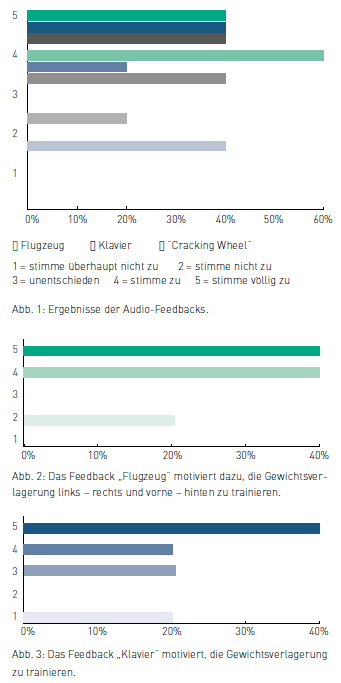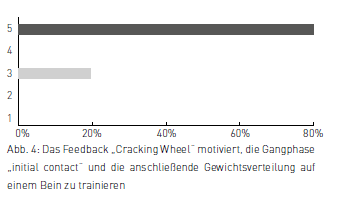
THERAPY-Magazin
Lyra audio feedback
Audio feedback systems like “Cracking Wheel” and “Airplane” show high potential in stroke rehab with the lyra gait trainer. A usability study reveals promising effects on gait correction, with room for improvement in real-time response and self-explanatory design.

Stefanie Ruh-Saxer
Product Manager and Clinical Application Specialist for THERA-Trainer Lyra
Audio feedback and the application of acoustic stimuli are considered effective for neurological rehabilitation in stroke patients. A usability test series examines the potential acceptance of the procedure by healthcare professionals.
Background
The literature shows that gait parameters such as speed, symmetry and step length can be changed in response to acoustic feedback. However, existing studies have only included patients without cognitive or neuro-psychological dysfunctions and who were able to understand instructions. Furthermore, these studies focused on stimulation or cueing, but not on real-time feedback. Therefore, the effect of auditory feedback in cognitively and neuro-physiologically impaired stroke patients is currently unknown.
The literature shows that gait parameters such as speed, symmetry and step length can be changed in response to acoustic feedback. However, existing studies have only included patients without cognitive or neuro-psychological dysfunctions and who were able to understand instructions. Furthermore, these studies focused on stimulation or cueing, but not on real-time feedback. Therefore, the effect of auditory feedback in cognitively and neuro-physiologically impaired stroke patients is currently unknown.
Objective
Healthcare professionals tested a total of three audio feedback scenarios for their user-friendliness, applicability and acceptance in rehabilitation. An analysis was carried out to determine whether the audio feedback scenarios are self-explanatory and can be understood without instruction. Further observation was made to establish whether healthcare professionals can adapt gait behaviour in response to the audio feedback. The experts also evaluated the applicability and potential acceptance of the feedback scenarios for rehabilitation.
Healthcare professionals tested a total of three audio feedback scenarios for their user-friendliness, applicability and acceptance in rehabilitation. An analysis was carried out to determine whether the audio feedback scenarios are self-explanatory and can be understood without instruction. Further observation was made to establish whether healthcare professionals can adapt gait behaviour in response to the audio feedback. The experts also evaluated the applicability and potential acceptance of the feedback scenarios for rehabilitation.
Methodology
The healthcare professionals were asked to test the audio feedback scenarios developed as part of this CTI project by first walking without a gait trainer and later with the lyra gait trainer. They were given instructions beforehand on how to behave and respond to the audio feedback. The test persons were observed and asked for their feedback. The three audio feedback scenarios tested were Airplane, Piano and Cracking Wheel. Open questions and standardised questionnaires for each feedback scenario, field notes and tape recordings were produced. The test persons were asked to test each audio feedback before and after instruction for a maximum of 5 minutes.
At the end of each round, participants were asked to rate the audio feedback on a Lickert scale from 1 “poor, unsuitable” to 5 “very good, very well adapted”, and to name positive and negative aspects experienced during the test. Feedback for each scenario was graphically summarised in bar charts. Feedback on open questions was condensed through content analysis and presented as statements.
The healthcare professionals were asked to test the audio feedback scenarios developed as part of this CTI project by first walking without a gait trainer and later with the lyra gait trainer. They were given instructions beforehand on how to behave and respond to the audio feedback. The test persons were observed and asked for their feedback. The three audio feedback scenarios tested were Airplane, Piano and Cracking Wheel. Open questions and standardised questionnaires for each feedback scenario, field notes and tape recordings were produced. The test persons were asked to test each audio feedback before and after instruction for a maximum of 5 minutes.
At the end of each round, participants were asked to rate the audio feedback on a Lickert scale from 1 “poor, unsuitable” to 5 “very good, very well adapted”, and to name positive and negative aspects experienced during the test. Feedback for each scenario was graphically summarised in bar charts. Feedback on open questions was condensed through content analysis and presented as statements.
Results
The tests were carried out on 19 July 2016 at Rehab Basel in Switzerland. Five healthcare professionals tested the three audio feedback scenarios in the same order. On average, the participants rated the lyra audio feedback as “good and well adapted”. Clear feedback was consistently given on the individual scenarios. The three audio feedback scenarios were found to be useful for correcting specific gait disorders, i.e. shifting body weight when standing and walking, and striking the heel in the initial contact phase.
The tests were carried out on 19 July 2016 at Rehab Basel in Switzerland. Five healthcare professionals tested the three audio feedback scenarios in the same order. On average, the participants rated the lyra audio feedback as “good and well adapted”. Clear feedback was consistently given on the individual scenarios. The three audio feedback scenarios were found to be useful for correcting specific gait disorders, i.e. shifting body weight when standing and walking, and striking the heel in the initial contact phase.


Discussion
In general, the tested audio feedback system had good acceptance among the test persons. Positive statements included “motivating”, “supporting” or “entertaining”. The most positive effects were observed for the Cracking Wheel and the Airplane. The audio feedback was positively received and even monotonous or sad tones such as the piano sound were not rated negatively, as patients with severe impairments would not be overwhelmed by this type of feedback. The audio feedback can therefore lead to a more specific form of training. Since some patients may not be able to understand verbal instructions, a self-explanatory audio feedback feature may be an option for correct patient guidance. In contrast, negative statements included that the audio feedback scenarios were not in real time and that some patients could be distracted or overwhelmed. Instruction was essential to make training more effective. The use of headphones can be disruptive for some patients and make them feel enclosed. Furthermore, observations of the test subjects showed that it was difficult to impossible to detect the intention of the specific audio feedback without prior instruction. In summary, the audio feedback via headphones was positively evaluated and is suitable as an adjunct to gait rehabilitation with the lyra. The focus of further developments should be improvements in terms of self-explanation and real time feedback.
In general, the tested audio feedback system had good acceptance among the test persons. Positive statements included “motivating”, “supporting” or “entertaining”. The most positive effects were observed for the Cracking Wheel and the Airplane. The audio feedback was positively received and even monotonous or sad tones such as the piano sound were not rated negatively, as patients with severe impairments would not be overwhelmed by this type of feedback. The audio feedback can therefore lead to a more specific form of training. Since some patients may not be able to understand verbal instructions, a self-explanatory audio feedback feature may be an option for correct patient guidance. In contrast, negative statements included that the audio feedback scenarios were not in real time and that some patients could be distracted or overwhelmed. Instruction was essential to make training more effective. The use of headphones can be disruptive for some patients and make them feel enclosed. Furthermore, observations of the test subjects showed that it was difficult to impossible to detect the intention of the specific audio feedback without prior instruction. In summary, the audio feedback via headphones was positively evaluated and is suitable as an adjunct to gait rehabilitation with the lyra. The focus of further developments should be improvements in terms of self-explanation and real time feedback.
Gait
lyra
Produkte
Science
THERAPY 2020-I
THERAPY Magazine

Stefanie Ruh-Saxer
Product Manager and Clinical Application Specialist for THERA-Trainer Lyra
Stefanie Ruh-Saxer is an experienced product manager and clinical application specialist. She played a key role in the development and implementation of the end-effector gait trainer Lyra. With her expertise, she has contributed to designing and establishing innovative solutions for neurological rehabilitation in clinical practice.
References:
Related contents
Find related exciting contents in our media library.
This is not what you are searching for? Knowledge
Meet our specialists.
Are you interested in our solutions? Schedule a meeting with a Consultant to talk through your strategy and understand how TEHRA-Trainer can help you to advance rehabilitation.